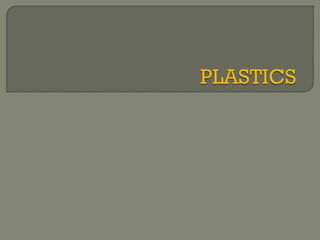
Plastics
- 2. Muhammad Umair Bukhari Engr.umair.bukhari@gmail.com www.bzuiam.webs.com 03136050151
- 3. Polymers. Macromolecules. Natural & synthetic Their unique properties have allowed them to replace metals. 1. strength: weight ratio 2. Designing with plastics 3. Cost of using plastics 4. Ease of manufacturing
- 4. plastic is cheaper than most metal weighs a lot less (better fuel economy). Plastic can be injection molded, vacuum molded, cast and generally machined or "worked" faster and cheaper than metal. for winter cold areas where the roads are salted, the corrosion resistance of plastics
- 5. Bio-plastic green phones Urethane bumpers
- 6. Thermoplastics: Amorphous structure. Secondary bonds. Linear & branched polymers have weak secondary bonds. Return to their original hardness when cooled. Reversible heating possible. Examples: acrylics, nylon, PVC, polyethene
- 7. Thermosets: Cross-linked in a 3d network. Strength of bond. Hardness & strength in material not affected by temperature. Polymerization will require heat & pressure so that the shape of the part is permanently set.(curing) Irreversible. Decomposes. Chars.
- 8. Tg not sharply defined. Become rubbery over a narrow range. Polymerization in 2 steps. At chemical plant & at parts-producing plant. Phenolics. Pots & pans. Possess better insulating, mechanical & chemical properties. Also better dimensional stability.
- 9. they need to be painted for UV protection. Tooling: Normally more expensive for plastic because of the surface finish required (in the mold) and the number of cavities are larger, thus increasing the cost.
- 10. Various chemical reactions were used to make cellulose in to cellulose acetate. Photographic films. Packaging sheets. So additives are added to impart certain specific properties. Modify properties like stiffness, strength, color, flammability, weatherability.
- 11. Fillers: improve mechanical properties. Decreases the cost/unit weight. Plasticizers: add flexibility & softness to the polymer by reducing Tg . Stabilizers: UV rays & oxygen tend to weaken & break the primary bonds. Degradation. Colorants Flame retardants
- 12. Cellulosics Fluorocarbons Polyamide (nylons) Polycarbonates Polyesters Polyethylenes Polypropylenes Polystyrenes PVC
- 14. Acrylic is a useful, clear plastic that resembles glass, but has properties that make it superior to glass in many ways. Common brands of high-grade acrylic include Plexiglass. moderate strength, good optical quality & weather resistance. Transparent but can be made opaque. Generally resistant to chemicals. Typical applications: lenses, signs, automotive lenses, window glazing, artificial nails, paints
- 15. For all of its advantages, there are two disadvantages of acrylic: it is more expensive than glass, and if exposed to a direct flame it will melt and eventually burn. Has good impact strength, higher than that of glass or polystyrene, but significantly lower than that of polycarbonate or engineering polymers. In the majority of applications, it will not shatter but instead breaks into large dull pieces.
- 16. ABS is impact resistant, abrasion & chemical resistant. Resistance to chemicals & corrosion. Does not ignite easily. Typical applications: pipes & fittings, tool handles, telephones & appliances. High performance at high & low temperatures. (-400 F to 1800 F)
- 17. The main disadvantage to using ABS pipe fittings are that it is not very durable when it comes to solvents or fatigue resistance. It also has minimal UV resistance, so should not be left exposed to the sun. The nitrile groups from neighboring chains, being polar, attract each other and bind the chains together, making ABS stronger than pure polystyrene
- 19. PVC has many advantages over pipes made of galvanized steel and copper. To begin with, it is the most lightweight of the three. This makes it easier to install. Also, it is the least expensive of the three types. Also, it can withstand higher water pressure than the copper. Also, PCV is non-conductive, will not rust, and is not as conducive to condensation.
- 20. Another advantage is that PVC can be placed under concrete slab without reacting to the concrete. Moreover, it is self-insulating. That is why it can handle hotter temperature water.
- 21. Even though it can withstand hot water temperatures, it is less flame resistant. That is one of the biggest disadvantages of PVC. Also, PVC contains volatile compounds which are harmful to the environment. Furthermore, some people have complained that PVC pipes cause water to have a slight plastic taste.
- 22. ElasticModulus & tensile strength decrease with increasing temperature. Toughness increases. Water absorption. Adverse affect. Solvents. Residual stresses. Radiation & visible light. Anisotropy due to cold rolling.
- 23. Friction& wear (self-lubricating, TEFLON) (gears, roller skate wheels, prosthetic joints) Thermal & electrical conductivity Low specific gravity (0.9-2.2) High coefficient of thermal expansion
